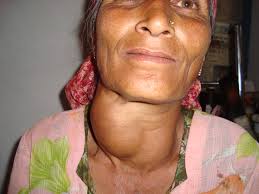11.11 – Iodine
Learning Objective
- Examine the role of Iodine in the body.
Recall the discovery of iodine and its use as a means of preventing goiter, a gross enlargement of the thyroid gland in the neck. Iodine is essential for the synthesis of thyroid hormone, which regulates basal metabolism, growth, and development. Low iodine levels and consequently hypothyroidism has many signs and symptoms including fatigue, sensitivity to cold, constipation, weight gain, depression, and dry, itchy skin and paleness. The development of goiter may often be the most visible sign of chronic iodine deficiency, but the consequences of low levels of thyroid hormone can be severe during infancy, childhood, and adolescence as it affects all stages of growth and development. Thyroid hormone plays a major role in brain development and growth. Fetuses and infants with severe iodine deficiency develop a condition known as cretinism, in which physical and neurological impairment can be severe. The World Health Organization (WHO) estimates insufficient iodine intake affects over two billion people worldwide and it is the number-one cause of preventable brain damage worldwide.1
1 World Health Organization. “Iodine Status Worldwide.” Accessed June 30, 2019.


Dietary Intake References for Iodine
The mineral content of foods is greatly affected by the soil from which it grew, and this geographic location is the primary determinant of the mineral content of foods. For instance, iodine comes mostly from seawater so the greater the distance from the sea the lower the iodine content in the soil.
| Age Group | R.D.A. Males and Females (micrograms per day) | U.L. |
|---|---|---|
| Infants (0–6 months) | 110* | None |
| Infants (7–12 months) | 130* | None |
| Children (1–3 years) | 90 | 200 |
| Children (4–8 years) | 120 | 300 |
| Children (9–13 years) | 150 | 600 |
| Adolescents (14–18 years) | 150 | 900 |
| Adults (> 19 years) | 150 | 1,100 |
*denotes Adequate Intake. Health Professional Fact Sheet: Iodine. National Institute of Health, Office of Dietary Supplements. Updated September 26, 2018. Accessed June 30, 2019.
| Food | Serving | Iodine (micrograms) | Percent Daily Value |
|---|---|---|---|
| Seaweed | 1 g. | 16 to 2,984 | 11 to 1,989 |
| Codfish | 3 oz. | 99 | 66 |
| Yogurt, low fat | 8 oz. | 75 | 50 |
| Iodized salt | 1.5 g. | 71 | 47 |
| Milk, reduced fat | 8 oz. | 56 | 37 |
| Ice cream, chocolate | ½ c. | 30 | 20 |
| Egg | 1 large | 24 | 16 |
| Tuna, canned | 3 oz. | 17 | 11 |
| Prunes, dried | 5 prunes | 13 | 9 |
| Banana | 1 medium | 3 | 2 |
Health Professional Fact Sheet: Iodine. National Institute of Health, Office of Dietary Supplements. Updated September 26, 2018. Accessed June 30, 2019.
Contributors
University of Hawai’i at Mānoa Food Science and Human Nutrition Program: Allison Calabrese, Cheryl Gibby, Billy Meinke, Marie Kainoa Fialkowski Revilla, and Alan Titchenal

